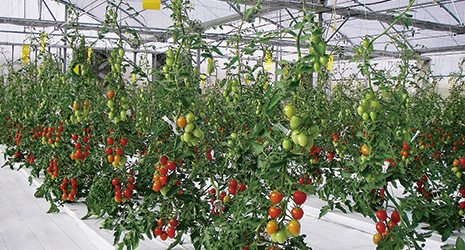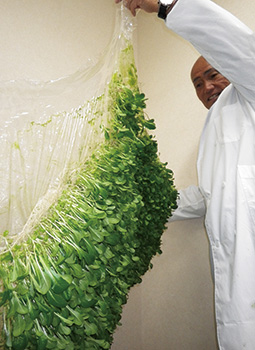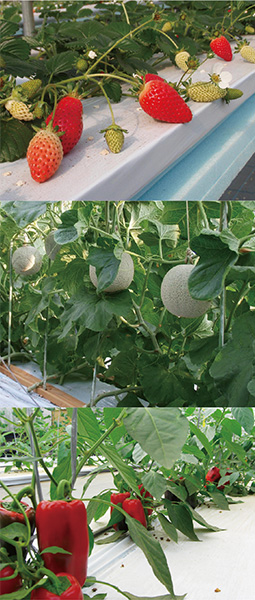April 2022
Film Farming, Making It Possible for Anyone to Farm Anywhere

Tomato cultivation using IMEC (Mebiol’s film farming method) -

Mebiol president Yoshioka Hiroshi (right) receiving the award Innovative Ideas and Technologies in Agribusiness (organized by UNIDO ITPO Italy) in Italy in May 2019

Mori Yuichi (chairman of Mebiol Inc.) shows how the plants extend their roots on the film surface 
Fruit and vegetable cultivation using IMEC

A breakthrough farming method has been developed that makes it possible for anyone to produce high-quality crops even in environments where crop cultivation is difficult.

The world today is facing climate change that causes extreme weather such as droughts and heavy rains, threatening stable production of crops.
In order to solve this problem, a farming method that can grow high-quality crops with a small amount of water and without using soil even in harsh environments has been developed. Named IMEC (intelligent membrane culture), it utilizes a technique called “film farming” that uses a special film instead of soil. It was developed by Mori Yuichi, the founder and current chairman of Mebiol Inc., a startup headquartered in Hiratsuka City, Kanagawa Prefecture.
Mori says, “I had been conducting research on medical devices using advanced polymer technology, such as artificial blood vessels and dialysis membranes, and thought that applying that technology to plant cultivation could contribute to solving the global food shortage problem, so I founded Mebiol in 1995.”
This film farming method IMEC uses “hydromembrane,” which is a special film with small holes on a nanometer scale (a nanometer is one billionth of a meter), instead of soil. The film is supplied with no more than moisture and nutrients through drip tubes, with the plants growing as they extend their roots on the surface of this film. If the nutrient solution is contaminated with viruses and bacteria, it cannot pass through the nanometer-sized holes, so the plants rarely get sick and it is possible to greatly reduce the amount of pesticide used.

Moreover, the waterproof sheet laid under the film does not leak the nutrient solution to the ground, and the water necessary for growth is only a fraction of the conventional amount, so crops can be grown even in places with little water. In addition, the plants are safe from soil pollution caused by excessive salinity and pests.
Moreover, this farming method helps improve the quality of crops. For example, it is easier to grow tomatoes with high sugar content and nutritional value than with conventional farming methods. Plants that grow tomatoes and other fruit have a property where they increase the sugar content and nutritional value of the fruit when there is water shortage, something that is known as “water stress.” IMEC makes it possible to adjust moisture to bring out this property.
Mori explains, “The surface of the hydromembrane looks dry at first glance, but in reality there is a small amount of moisture and nutrients inside the film. Plants try to take in the trace amounts of moisture and nutrients over a larger area by rooting on the surface of the film and extending fine root hairs. As this happens, the plants undergo ‘water stress,’ which results in high sugar content and nutritional value.”
There already existed farming methods that use “water stress,” but the amount of water and timing have been difficult to adjust. However, with this farming method, you do not need time-consuming moisture management, and even those who have no experience in agriculture can learn the cultivation techniques in a short period of time, allowing them to produce high-quality crops.
Mebiol’s film farming method has been recognized for contributing to the SDGs advocated by the United Nations. It has been awarded many awards. For example, in 2017, it was awarded the Director General of Small and Medium Enterprise Agency Award at the Japan Venture Awards hosted by the Organization for Small & Medium Enterprises and Regional Innovation, Japan, and in 2019, the international award Innovative Ideas and Technologies in Agribusiness by the Italian Investment and Technology Promotion Office of the United Nations Industrial Development Organization (UNIDO ITPO Italy).

IMEC has been patented in more than 120 countries, and the company is working to introduce it around the world. In the United Arab Emirates (UAE), tomatoes have been produced in a 5,000-square-meter greenhouse that uses IMEC since 2014, with produce being shipped to local high-end restaurants. Since 2015, tomato cultivation using IMEC has also been done near Shanghai in China. Moreover, in 2020, the Japan International Cooperation Agency (JICA) decided to conduct a survey for the introduction of IMEC in the Republic of Kenya as one of their SDGs Business Supporting Surveys. The company aims to facilitate stable production of high-quality, highly nutritious crops in Kenya, which suffers from unstable rainfall and other adverse weather phenomena.
Mori comments, “The IMEC technology enables agriculture in areas where it has previously been difficult due to climate and soil conditions, so now we can expand farmland more and more.”
The company is working to support economic revitalization and help people break free from poverty by establishing agriculture in drought-stricken areas in Africa and around the world, as well as conducting research to make pharmaceuticals from genetically modified plants grown with IMEC. Mori is working hard toward the goal of expanding arable land around the world through IMEC and maximizing its economic impact.



